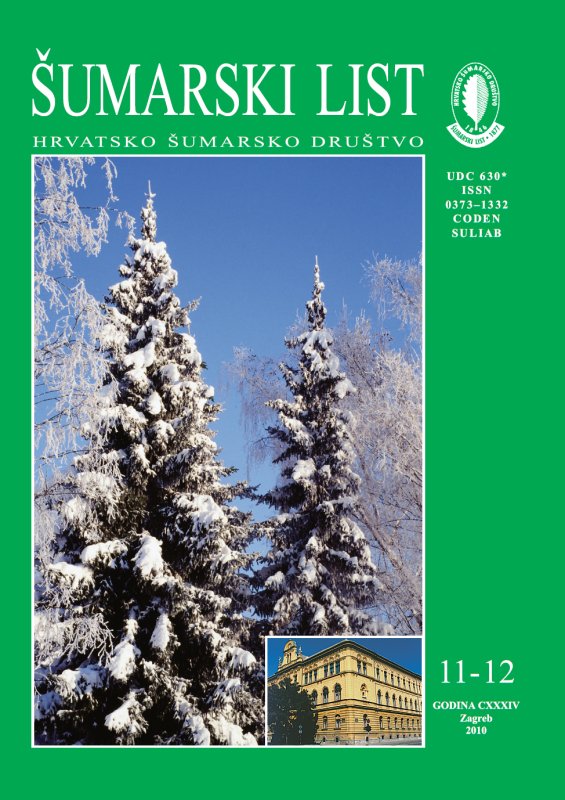
broj: 11-12/2010
pdf (7,55 MB) |
|
||||||||||||||
| RIJEČ GLAVNOGA UREDNIKA | ||
| Branimir Prpić | ||
| AT THE END OF THE YEAR pdf HR EN | 557 | |
| When a year is ending, it is a custom to draw a line under the results, analyze the achievements and decide whether the tasks set at the beginning of the year have been completed with more or less success. This time, however, we will focus on what is in store for us in the year 2011. It was on the proposal of the Croatian delegation at the 2007 UN Ministerial Conference in New York that the year 2011 was declared the International Year of Forests. It is common knowledge that the year 2002 was the International Year of Mountains, the year 2003 was dedicated to water, the year 2006 to soil protection, the years 2007, 2008 and 2009 were the International Years of Planet Earth, and the year 2010 was the International Year of Biodiversity. All these declarations and celebrations are aimed at highlighting the problems of the preservation and improvement of their condition, as well as stimulating the public to join the experts in nature protection effort. The world population is rapidly increasing (in the mid nineteenth century there were 3 million people, compared to the current number of almost 7 billion people). Technological advancement, irresponsible treatment of the nature, and unscrupulous profiteering pose a serious threat to nature. The forest is the most complex ecosystem which requires particular attention. As we can see, the international community has made full acknowledgement of this fact by dedicating one year to its celebration. Yet, love for the nature is not enough; what we also need is the knowledge of its aspects, in this case of forests. This is the argument which we often use in our dialogues with various modern nature protectors. The working group of the Ministry of Regional Development, Forestry and Water Management has planned a variety of activities to mark the International Year of Forests, to which the Croatian Forestry Association will contribute with their action programme. Most of the activities are educational in character. The Croatian forestry profession should use this opportunity to present itself to the public in the proper light and to disclaim the most frequent and usually negative public perception of forestry as the art of the axe and the log. There is no need to discard the log, because as the final product it becomes a useful object in the life of the man, but the public should know that it is only a by-product of silviculture, protection and regeneration of forests. Incidentally, the price of this log in Croatia is far below its market value. What we must focus on are the non-market values of the forest (commercial, ecological and social), which we ensure with our professional work based on the principles of sustainable management. We should explain why we advocate silvicultural treatments in forests, or in other words, why we support active rather than passive protection. It is a known fact that people appreciate the value of a thing only after they have lost it, which we would on no account want to happen to forests. In implementing the programme of marking the International Year of Forests2011, we expect full support of the media. Unfortunately, articles in the daily press related to forests and forestry are generally negatively intoned; in other words, instead of being educative, they prefer to focus on so-called “cases”. Forests and forestland cover 46% of the land area of Croatia. They have been preserved and tended by the forestry profession, so it seems almost incredible that the national television, except for some feeble attempts, does not have at least one regular informative-educative programme on forests and forestry. If we can watch the Agricultural programme and the programme about the sea every Sunday, then there is no reason why we should not watch a similar programme on forests and forestry. Can we have such a programme at least in the International Year of Forests2011? We expect that the forestry profession will use the International Year of Forests as an opportunity to present itself in the proper light. In conclusion, we wish all the readers of the Forestry Journal Merry Christmas and a Very Happy and Successful New Year 2011. Professor Emeritus Branimir Prpić, Ph.D. | ||
| IZVORNI ZNANSTVENI ČLANCI | ||
| Vukelić, J., A. Alegro, V. Šegota, I. Šapić | UDK 630* 188 + 174.7 (001) | |
| Nomenclatural-Phytocoenological revision of the Association Calamagrostio variae-Piceetum dinaricum Bertović 1975, nom. illeg. in Croatia pdf HR EN | 559 | |
| Zebec, M., M. Idžojtić, I. Poljak, I. Mihaldinec | UDK 630* 164 (001) | |
| The Variability of Field Elm (Ulmus minor Mill. sensu latissimo) in Croatian Drava River Valley According to the Leaf Morphology pdf HR EN | 569 | |
| Cojzer, M., R. Brus | UDK 630* 182 (001) | |
| Species Composition and Successional Pathways on Abandoned Agricultural Land in Haloze pdf HR EN | 581 | |
| PRETHODNO PRIOPĆENJE | ||
| Cetl, V., B. Barišić, I. Šarušić | UDK 630* 582 | |
| Transfer of Cadastral data into the New State Coordinate System HTRS96/TM pdf HR EN | 593 | |
| PREGLEDNI ČLANCI | ||
| Kovácsová, P., M. Antalová | UDK 630* 589 | |
| Precision Forestry – Definition and Technologies pdf HR EN | 603 | |
| Landekić, Matija | UDK 630* 302 + 384 | |
| Organizational Culture and Occupational Safety in the Croatian Forestry Sector pdf HR EN | 613 | |
| Balenović, I., H. Marjanović, M. Benko | UDK 630* 569 + 587 | |
| Application of Aerial Photographs in Forest Management in Croatia pdf HR EN | 623 | |


